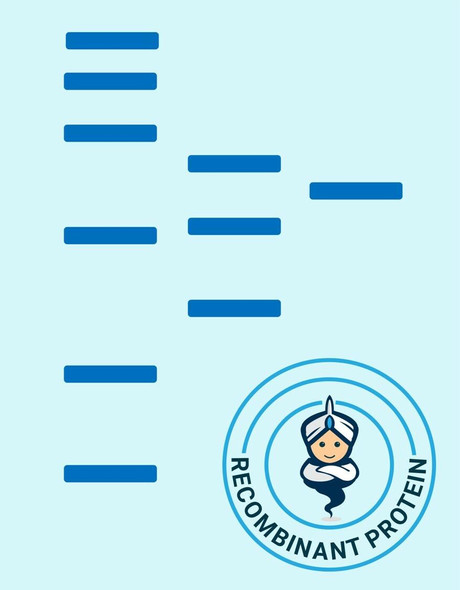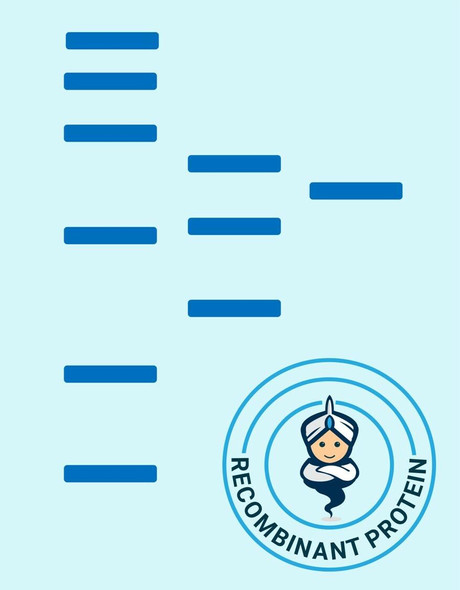Cytokines Recombinant Proteins
Mouse IL12 Recombinant Protein (RPPB0571)
- SKU:
- RPPB0571
- Product Type:
- Recombinant Protein
- Species:
- Mouse
- Uniprot:
- P43432
- Research Area:
- Cytokines
Description
| Product Name: | Mouse IL12 Recombinant Protein |
| Product Code: | RPPB0571 |
| Size: | 10µg |
| Species: | Mouse |
| Target: | IL12 |
| Synonyms: | Interleukin 12 (subunit beta/alpha), IL12b/IL12a, Il-12b/Il-12a, IL-12p40/Il-12p35, Il12p40/Il12p35, p40/p35, Sf9. |
| Source: | Sf9 Insect cells |
| Physical Appearance: | Sterile Filtered clear solution. |
| Formulation: | IL12 protein solution (0.5mg/ml) contains phosphate buffered saline (pH7.4) and 10% glycerol. |
| Stability: | Store at 4°C if entire vial will be used within 2-4 weeks. Store, frozen at -20°C for longer periods of time. Please avoid freeze thaw cycles. |
| Purity: | Greater than 95.0% as determined by SDS-PAGE. |
| Amino Acid Sequence: | IL12B(p40)MWELEKDVYV VEVDWTPDAP GETVNLTCDT PEEDDITWTS DQRHGVIGSG KTLTITVKEF LDAGQYTCHK GGETLSHSHL LLHKKENGIW STEILKNFKN KTFLKCEAPN YSGRFTCSWL VQRNMDLKFN IKSSSSSPDS RAVTCGMASL SAEKVTLDQR DYEKYSVSCQ EDVTCPTAEETLPIELALEA RQQNKYENYS TSFFIRDIIK PDPPKNLQMK PLKNSQVEVS WEYPDSWSTP HSYFSLKFFV RIQRKKEKMK ETEEGCNQKG AFLVEKTSTE VQCKGGNVCV QAQDRYYNSS CSKWACVPCR VRSIL12A(p35)RVIPVSGPAR CLSQSRNLLK TTDDMVKTAR EKLKHYSCTA EDIDHEDITR DQTSTLKTCL PLELHKNESC LATRETSSTT RGSCLPPQKT SLMMTLCLGS IYEDLKMYQT EFQAINAALQ NHNHQQIILD KGMLVAIDEL MQSLNHNGET LRQKPPVGEA DPYRVKMKLC ILLHAFSTRVVTINRVMGYL SSAHHHHHH� |
| Biological Activity: | The activity is determined by the IFN-g ELISA in a using NK-92 human natural killer cells. The ED50 for this effect is less or equal to 10ng/ml. |
interleukin 12 subunit beta/alpha or IL12b/IL12a is a growth factor cytokine which increases the lytic activity of NK/lymphokine-activated killer cells, activated T and NK cells and prompt IFN-gamma production (through resting PBMC). IL12b/IL12a is a crucial part to the process of cellular-immunity and activates the differentiation of Th1 cells originates from the precursor T helper cells. The protein is linked to IL23A and creates the IL-23 interleukin, by that, the autoimmune inflammation is induced and autoimmune inflammatory diseases and tumorigenesis are being affected.�
IL12 Mouse Recombinant produced in a baculovirus expression system is a glycosylated disulfide linked (through cysteines in bold) heterodimer comprised of IL12A (23-335aa, total of 319 aa, MW 35.7kDa) and IL12B (23-215aa, total of 199 aa, MW 22.5kDa), having a total predicted molecular mass of 58.3kDa (Molecular weight on SDS-PAGE will appear higher). IL12A is fused to a 6 amino acid His-Tag at C-terminus and purified by proprietary chromatographic techniques.
| UniProt Protein Function: | IL12B: Cytokine that can act as a growth factor for activated T and NK cells, enhance the lytic activity of NK/lymphokine- activated killer cells, and stimulate the production of IFN-gamma by resting PBMC. Defects in IL12B are a cause of mendelian susceptibility to mycobacterial disease (MSMD); also known as familial disseminated atypical mycobacterial infection. This rare condition confers predisposition to illness caused by moderately virulent mycobacterial species, such as Bacillus Calmette-Guerin (BCG) vaccine and environmental non-tuberculous mycobacteria, and by the more virulent Mycobacterium tuberculosis. Other microorganisms rarely cause severe clinical disease in individuals with susceptibility to mycobacterial infections, with the exception of Salmonella which infects less than 50% of these individuals. The pathogenic mechanism underlying MSMD is the impairment of interferon-gamma mediated immunity, whose severity determines the clinical outcome. Some patients die of overwhelming mycobacterial disease with lepromatous-like lesions in early childhood, whereas others develop, later in life, disseminated but curable infections with tuberculoid granulomas. MSMD is a genetically heterogeneous disease with autosomal recessive, autosomal dominant or X-linked inheritance. Genetic variations in IL12B are a cause of susceptibility to psoriasis type 11 (PSORS11). Psoriasis is a common, chronic inflammatory disease of the skin with multifactorial etiology. It is characterized by red, scaly plaques usually found on the scalp, elbows and knees. These lesions are caused by abnormal keratinocyte proliferation and infiltration of inflammatory cells into the dermis and epidermis. Belongs to the type I cytokine receptor family. Type 3 subfamily. |
| UniProt Protein Details: | Protein type:Secreted, signal peptide; Cytokine; Secreted Cellular Component: cytoplasm; extracellular space; interleukin-12 complex Molecular Function:cytokine activity; growth factor activity; hematopoietin/interferon-class (D200-domain) cytokine receptor binding; identical protein binding; interleukin-12 alpha subunit binding; interleukin-12 receptor binding; interleukin-23 receptor binding; protein binding; protein heterodimerization activity; protein homodimerization activity Biological Process: cell cycle arrest; cell migration; cell surface receptor linked signal transduction; defense response to Gram-negative bacterium; defense response to protozoan; defense response to virus; natural killer cell activation; natural killer cell activation during immune response; negative regulation of inflammatory response to antigenic stimulus; negative regulation of interleukin-10 production; negative regulation of interleukin-17 production; negative regulation of smooth muscle cell proliferation; positive regulation of activated T cell proliferation; positive regulation of cell adhesion; positive regulation of defense response to virus by host; positive regulation of granulocyte macrophage colony-stimulating factor production; positive regulation of interferon-gamma biosynthetic process; positive regulation of interferon-gamma production; positive regulation of interleukin-10 production; positive regulation of interleukin-12 production; positive regulation of interleukin-17 production; positive regulation of lymphocyte proliferation; positive regulation of mononuclear cell proliferation; positive regulation of natural killer cell activation; positive regulation of natural killer cell mediated cytotoxicity directed against tumor cell target; positive regulation of natural killer cell proliferation; positive regulation of NK T cell activation; positive regulation of NK T cell proliferation; positive regulation of osteoclast differentiation; positive regulation of T cell mediated cytotoxicity; positive regulation of T cell proliferation; positive regulation of T-helper 1 type immune response; positive regulation of tumor necrosis factor production; positive regulation of tyrosine phosphorylation of Stat3 protein; positive regulation of tyrosine phosphorylation of Stat4 protein; positive regulation of tyrosine phosphorylation of Stat5 protein; regulation of tyrosine phosphorylation of Stat1 protein; response to organic substance; response to UV-B; sensory perception of pain; T-helper cell differentiation |
| NCBI Summary: | This gene encodes the beta subunit p40 of the Interleukin 12 (IL-12) family of cytokines. Members of the IL-12 family form heterodimers consisting of heavy and light subunits linked by disulfide bonds. The product of this gene, p40, is a subunit of interleukins IL-12 and IL-23. [provided by RefSeq, Dec 2014] |
| UniProt Code: | P43432 |
| NCBI GenInfo Identifier: | 1170461 |
| NCBI Gene ID: | 16160 |
| NCBI Accession: | P43432.1 |
| UniProt Secondary Accession: | P43432,Q9QUM1, |
| UniProt Related Accession: | P43432 |
| Molecular Weight: | 38,235 Da |
| NCBI Full Name: | Interleukin-12 subunit beta |
| NCBI Synonym Full Names: | interleukin 12b |
| NCBI Official Symbol: | Il12b�� |
| NCBI Official Synonym Symbols: | p40; Il-12b; Il12p40; Il-12p40�� |
| NCBI Protein Information: | interleukin-12 subunit beta |
| UniProt Protein Name: | Interleukin-12 subunit beta |
| UniProt Synonym Protein Names: | Cytotoxic lymphocyte maturation factor 40 kDa subunit; CLMF p40; IL-12 subunit p40 |
| Protein Family: | Interleukin |
| UniProt Gene Name: | Il12b�� |
| UniProt Entry Name: | IL12B_MOUSE |






